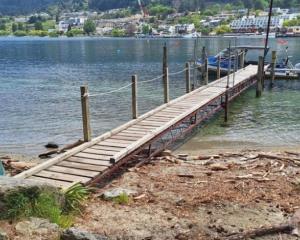"It’s exciting," Georgia Pope, one of four Otago Polytechnic students who completed the course with exams earlier this week, said.
"I can’t wait to graduate. Studying for five years has been a long time."
The polytechnic has offered a three-year undergraduate degree in architecture, with specialisations in architecture technology and interior architecture, since 2017 but the master’s programme was only introduced in 2023.
After finishing the two-year fulltime course — the only one of its kind in the South Island — graduates need to complete three or more years of professional experience before they can apply to become registered architects.
Architecture head Associate Prof Tobias Danielmeier said while only four students would graduate this year, there were 11 in the next cohort and 20 in the year group after that.
The master’s programme allowed students to develop advanced knowledge of complex architectural and heritage design opportunities, undertake a major research project and explore what it took to create first-class work in a collaborative environment, he said.
Graduates needed to be able to handle complexity and in a world where AI was becoming more important, critical thinking was vital. Sustainability was also a key focus of the programme.
In the final year, students investigated a topic in depth for their thesis but the study was not only theoretical as they had to find a design solution for a specific site. For the graduating students, those ranged from a scout camp at the head of Lake Wakatipu to a high-density apartment complex in central Dunedin.
All of the group had earned design or industry awards and were already working in the industry.
Otago has a long association with the practice of architecture. According to Southern Architects: A history of the southern branch of NZIA, by Norman Ledgerwood, a short-lived Otago Institute of Architects was founded in 1862, the same year that New Zealand’s oldest continuing practice, Dunedin’s Mason & Wales, began. The branch was reactivated in 1900 and five years later, Otago architects were instrumental in forming the New Zealand Institute of Architects (NZIA).
The current crop of students arrived at architecture in different ways, Nicolas Sharp saying it seemed a good balance of science and creativity.
Miss Pope was influenced by her hard materials teacher at high school.
"He pushed us girls to pursue something in the construction industry.
"I know a few of the others went off to be builders and I loved the design side of it."
Hunter Dale said he had always loved "building, drawing and making", though his idea of what housing looked like had changed over the years, from standalone dwellings to "more high-density stuff".
The past two years had been busy and challenging, as they worked as architectural technicians in addition to their course work, they said. However, they enjoyed learning from each other, as well as from their lecturers.
Desmond ’Emila Makasini Marculy Ola (Mila Makasini) felt bringing the degree to the South was no small feat for Otago Polytechnic and would leave a "good legacy" for architecture in the province.
Miss Pope said they had a lot of freedom in deciding what they wanted to study and many institutions did not allow for that: "I think a lot of industry people who I’ve talked to are quite interested in seeing what we can do now."
She admires the work of the late Maori architect Rewi Thompson, and is interested in how indigenous thinking can lead to a more sustainable future.
Next year, she will move to the United Kingdom, where there is the chance to work in niche areas — one New Zealand graduate she knows of designs nuclear power plants.
"We learn about all the different places overseas and I want to see them all, so [the plan is to] work somewhere close to Europe, I guess."
Mr Sharp is interested in educational buildings and enthusiastic about "place-based architecture", which he said the Otago programme promotes.
Mr Dale hopes to create affordable, well-designed high-density housing and to eventually move to Melbourne, which he says does apartments particularly well.
Mr Makasini will work towards registration in Dunedin and says after that, "the sky’s the limit".
Interested in public buildings that have a social impact, he would like to help design government facilities such as schools in his family’s home country, Tonga.
When asked what he enjoyed about architecture, he said it was the entire process, from consulting with clients and refining plans to engaging contractors and being on site. One of the first projects he was involved with was the Mosgiel pool, where he got to work with a diverse group of people.
The appeal for Miss Pope was that architecture blended building with art.
"A lot of people think it’s just putting up a box with a roof, but it can be a lot more than that." With the research that I’ve done over the last year, I really like the idea of architecture being a facilitator, connecting people to place and people to practices."
For Mr Sharp, a good architect is someone who understands what is needed and who creates something beautiful out of that, "rather than creating aesthetic architecture for the sake of aesthetic architecture".
"Architecture is an exciting field to be in, in terms of producing not just buildings but stories and moments for other people to enjoy and share," he said.

























